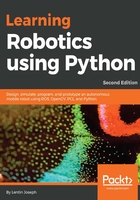
Modeling the Differential Drive Robot
In this chapter, we will look at how to model the differential drive robot and create the URDF model of this robot in ROS. The main use case of the robot that we are going to design in this chapter is to serve food and drinks in hotels and restaurants. The robot is named Chefbot. We will cover the complete modeling of this robot in this chapter.
We will look at the CAD design of various mechanical components used in this robot and how to assemble them. We will look at the 2D and 3D CAD design of this robot and will discuss how to create the URDF model of the robot.
The actual robot model deployed in hotels may be big in size, but here we intend to build a miniature version for testing our software. If you are interested in building a robot from scratch, this chapter is for you. If you are not interested in building the robot, you can choose some robotic platforms, such as Turtlebot, which are already available on the market, to work with this book.
To build the robot hardware, first we need to get the requirements of the robot. After getting the requirements, we can design it and draw the model in 2D CAD tools to manufacture the robot parts. The 3D modeling of the robot will give us more idea about the looks of the robot. After the 3D modeling, we can convert the design into a URDF model that can be used along with ROS.
The following topics will be covered in the chapter:
- Designing robot parameters from the given specification
- Designing robot body parts in 2D using LibreCAD
- Designing a 3D robot model using Blender and Python
- Creating a URDF model for Chefbot
- Visualizing the Chefbot model in Rviz